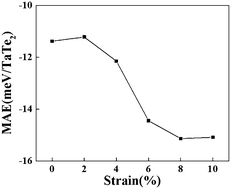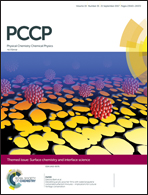Large magnetic anisotropy and strain induced enhancement of magnetic anisotropy in monolayer TaTe2
Abstract
Monolayer TaTe2 holds great potential for the realization of large magnetocrystalline anisotropy due to strong spin–orbit coupling (SOC) interactions of Ta. Here, we systematically investigate the electronic structure, magnetism and magnetocrystalline anisotropy of monolayer TaTe2 under different strains by means of first-principles calculations. The results show that monolayer TaTe2 is a ferromagnetic metal and exhibits a large in-plane magnetic anisotropy energy (MAE) of −11.38 meV per TaTe2. It is worth noting that the magnetic moment, magnetic coupling and magnetic anisotropy of monolayer TaTe2 are significantly enhanced by strain. In particular, when tensile strain increases from 0% to 8%, the MAE of monolayer TaTe2 greatly increases from −11.38 to −15.14 meV per TaTe2. By analyzing the density of states and the contribution to magnetocrystalline anisotropy (MCA) from the SOC interaction between two d orbitals of Ta atoms based on second-order perturbation theory, it is concluded that a large MAE of monolayer TaTe2 is mainly contributed by the SOC interaction between opposite spin dxy and dx2−y2 orbitals of Ta atoms and the significant increase of the negative contribution to MCA from the SOC interaction between opposite spin dxy and dx2−y2 orbitals under strain is the reason why the MAE of monolayer TaTe2 is significantly enhanced by strain. Our results indicate that monolayer TaTe2 is a promising candidate suitable for applications in magnetic storage devices.



 Please wait while we load your content...
Please wait while we load your content...